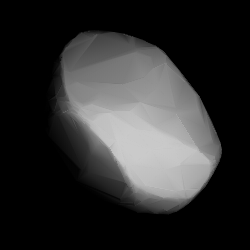 Shape of Eleutheria from modeled lightcurve Shape of Eleutheria from modeled lightcurve | |
| Discovery | |
|---|---|
| Discovered by | Paul Götz |
| Discovery site | Heidelberg |
| Discovery date | 28 May 1905 |
| Designations | |
| MPC designation | (567) Eleutheria |
| Pronunciation | /ɛljuːˈθɪəriə/ |
| Alternative designations | 1905 QP |
| Orbital characteristics | |
| Epoch 31 July 2016 (JD 2457600.5) | |
| Uncertainty parameter 0 | |
| Observation arc | 110.89 yr (40504 d) |
| Aphelion | 3.4182 AU (511.36 Gm) |
| Perihelion | 2.8471 AU (425.92 Gm) |
| Semi-major axis | 3.1327 AU (468.65 Gm) |
| Eccentricity | 0.091156 |
| Orbital period (sidereal) | 5.54 yr (2025.2 d) |
| Mean anomaly | 61.183° |
| Mean motion | 0° 10 39.936 / day |
| Inclination | 9.2562° |
| Longitude of ascending node | 58.278° |
| Argument of perihelion | 133.321° |
| Physical characteristics | |
| Mean radius | 46.705±1.1 km |
| Synodic rotation period | 7.717 h (0.3215 d) |
| Geometric albedo | 0.0439±0.002 |
| Absolute magnitude (H) | 9.16 |
567 Eleutheria is a minor planet orbiting the Sun.
Photometric observations of this asteroid made during 2010 showed a rotation period of 7.718±0.001 h with a brightness variation of 0.34±0.02 in magnitude.
References
- Noah Webster (1884) A Practical Dictionary of the English Language
- "567 Eleutheria (1905 QP)". JPL Small-Body Database. NASA/Jet Propulsion Laboratory. Archived from the original on 17 September 2020. Retrieved 5 May 2016.
- Pilcher, Frederick (October 2010), "Rotation Period Determinations for 80 Sappho, 145 Adeona, 217 Eudora, 274 Philagoria, 567 Eleutheria, and 826 Henrika", Bulletin of the Minor Planets Section of the Association of Lunar and Planetary Observers, 37 (4): 148–149, Bibcode:2010MPBu...37..148P.
External links
- 567 Eleutheria at AstDyS-2, Asteroids—Dynamic Site
- 567 Eleutheria at the JPL Small-Body Database

| Minor planets navigator | |
|---|---|
| Small Solar System bodies | |||||||
|---|---|---|---|---|---|---|---|
| Minor planets |
| ||||||
| Comets | |||||||
| Other | |||||||
This article about an asteroid native to the asteroid belt is a stub. You can help Misplaced Pages by expanding it. |